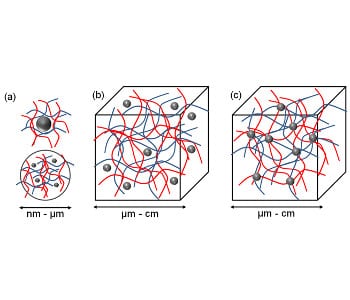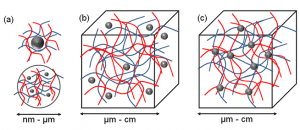As the name suggests, nanoparticle–hydrogel composites are functional materials made through the combination of nanoparticles and hydrogels via various mechanisms. Three different designs currently exist: inorganic or polymer nanoparticles stabilized on micro- or nanoscale hydrogels (a); nanoparticles immobilized on a hydrogel matrix via non-covalent interactions (b); and nanoparticles immobilized on a hydrogel matrix via covalent interactions (c). The latest issue of the new journal Advanced Science kicks off with a review of these promising materials by Xian Juh Loh and co-workers. Serving as an overview into the concept, design, and applications of these composites, the authors hope their review will serve as “a tool for selecting an appropriate method for achieving a desired nanoparticle–hydrogel composite”. They also look at the potential applications of these materials and the possible challenges faced in their development.
There are five main approaches that can be used to obtain nanoparticle–hydrogel composites, and the authors begin by looking at these methods in detail. The simplest method is gelation of a suspension of nanoparticles in a hydrogel-forming monomer solution. Gelation can also be used as the first step in a two-step process, after which the nanoparticles are physically incorporated onto the hydrogel matrix via what the authors describe as a “breathing in” mechanism. The nanoparticles can also be created in situ after gelation of the hydrogel and subsequent conversion of the nanoparticle precursors suspended in the gel. One particularly innovative method involves making use of crosslinker groups on the nanoparticle surface to form the hydrogel matrix. Finally, the composite material can be created by using a distinct gelator molecule to form positively charged polymers into hydrogels.
The different types of nanoparticle–hydrogel composite and their applications are then reviewed by the authors. Metal nanoparticles used in the formation of the composites include those based on gold, silver, nickel, and copper. There have even been reports of bimetallic nanoparticles being used, including one based on iron and cobalt. Such composites based on metal nanoparticles have many potential medical applications, which the authors look at in more detail.
Metal oxide nanoparticles can also be used in the formation of these composite materials, allowing researchers to take advantage of their ferromagnetic and semi-conducting properties. Non-metallic nanoparticles (e. g, graphene, quantum dot, silicon) and polymeric nanoparticles (e.g., micelles, nano-gels, dendrimers) are also briefly reviewed by the authors.
In the coming years, research into the design of nanoparticle–hydrogel composites will boost our understanding of the fundamental material interactions occurring within these materials at the molecular level. No doubt, as the authors acknowledge, this will greatly expand the range of applications available to these interesting materials and allow further research to be conducted into the potential properties of new composites.
Advanced Science is a new journal from the team behind Advanced Materials, Advanced Functional Materials, and Small. The journal is fully Open Access and is free to read now at www.advancedscience.com.


















